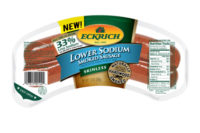Sodium chloride, or table salt, is the most common non-meat adjunct added to further processed products. In addition, sodium chloride is one of the primary functional ingredients in processed meat products, and, as such, has multiple functions.
First, salt functions to add flavor to meat products through both the saltiness, but also to enhance the flavor of other flavors in the meat products. Second, salt functions in the extraction of salt-soluble myofibrillar proteins.
“The ability of salt to solubilize the myofibrillar proteins is of vital importance to the successful manufacture of emulsified sausages,” explains Wes Schilling, a professor of food science in the Department of Food Science, Nutrition and Health Promotion for Mississippi State University. “Salt solubilizes myofibrillar proteins by increasing the electrostatic repulsion between the filaments and alleviates some of the structural constraints of myofibrillar proteins.”
During proper thermal processing, the denaturation and aggregation of the extracted proteins, protein gelation, provide the proper bind and texture of comminuted and restructured meat products, adds Gary Sullivan, assistant professor of meat processing in the Department of Animal Science at the University of Nebraska-Lincoln. “Without other functional ingredients, such as sodium phosphate, there is a minimum amount of salt necessary to allow for adequate protein extraction,” he explains. “Research has suggested that a minimum of 1.75 percent salt for lean products, such as ham, and 1.4 percent salt for higher fat products, such as sausages.”
Salt also functions in moisture retention and yield. “Along with the proper protein extraction and binding helping to hold water in the system, the ionic charges of the salt, sodium chloride, also help to increase the moisture retention improving yield and palatability,” Sullivan says.
In addition, salt originally was used to preserve meat products and still provides this function in some products, such as prosciutto. However, most products do not have the amount of salt necessary to preserve meat fully in this way, but some have enough to slow the growth of microorganisms, Sullivan explains.
Methods to reduce sodium
Even with all of sodium chloride’s multi-functions, more than a decade ago many food processors began a concerted effort to reduce salt in food products. “One difference with the current trend is there is a broader effort to reduce sodium and not just in reduced or low-sodium versions of products,” Sullivan says. “Processors have reduced salt more gradually as to make the changes not as noticeable to consumers.”
Processors can use a variety of methods to reduce the overall sodium content of meat products by replacing salt with a salt substitute like potassium chloride or/and a blend of sodium chloride and potassium chloride along with using reduced sodium sea salt, says Wesley Osburn, an associate professor in the Department of Animal Science at Texas A&M University in College Station. Reducing salt content and adding other ingredients, i.e., starches, fibers, gums, to help replace the important functional properties of salt is another option, he adds. Processor sodium reduction strategies may include reformulation of products to reduce phosphate, erythorbate and nitrite. Another option is enhancing production steps through the use of vacuum tumbling, chopping or stuffing along with modifying the thermal processing schedule, Osburn explains.
Schilling sees three major approaches used to reduce sodium content in muscle food products. These include using salt substitutes with masking agents, using flavor enhancers in combination with sodium chloride, and optimizing the salt so that it provides as much flavor as possible to the meat system. “These approaches are the most viable options for reducing sodium, because potassium chloride can provide the desired protein functionality requirements in the meat system, but negatively impacts the flavor of the product,” he explains.
To prevent a negative effect on flavor, other ingredients must be used. “The most common technology that is used to replace salt in food products is to substitute sodium chloride with potassium chloride at levels of 20 to 50 percent,” Schilling says. “Potassium chloride is the only ingredient that is capable of providing similar improvements in protein functionality to that of sodium chloride, which is expressed in water and fat binding in processed products. Calcium chloride and magnesium chloride can also be used but do not extract/solubilize myofibrillar proteins as well as potassium chloride or sodium chloride. Potassium chloride replaces the functionality that is imparted by sodium chloride in processed meat products, but it does not impart the desired salty taste or enhance the desirable sensory properties of the product.”
As salt is not the only sodium-containing ingredient that is used in processed meats, potassium salts are one method to reduce sodium where sodium lacate can be replaced by potassium lactate, Sullivan says. “Potassium chloride can provide similar functionality to sodium chloride but replacement amounts can be limited due to bitter off-flavors,” he explains. “Although sodium phosphate contains sodium itself, it synergistically acts with salt to extract proteins and can be achieved with salt concentrations lower than the above-stated minimums. This results in a net reduction in sodium.”
In addition, pre-blending is a processing technique that could be used to reduce sodium by adding salt to lean meat, mixing and holding overnight to maximize protein extraction, Sullivan adds. “The remaining lean meat, fatter meat and pre-blend can be mixed to achieve target sodium level,” he explains.
Sodium reduction challenges
Reduction of sodium chloride is challenging for the entire food industry due to both flavor and protein functionality issues that result in bland products that are not as juicy or tender and do not have optimal texture.
“The main way these challenges are being overcome are by conducting sensory, microbiological and safety testing that is necessary to determine how low sodium, predominantly in the form of salt can be lowered in specific applications without negatively impacting the sensory properties, shelf-life and safety of the product,” Schilling says. “Flavor enhancers, natural flavors, post-package sterilization, hydrostatic pressure, etc., can also be used to help lower sodium. Any technological advancement and ingredient technology that helps with flavor, protein extraction and shelf-life can also be used.”
Osburn agrees the challenge in replacing salt is that it is the primary functional ingredient in most processed meat products. “It activates meat proteins to bind water, fat and other proteins and it significantly impacts product texture, yield, flavor and shelf life,” he explains. “Modification — reduction or replacement — of salt content will impact these product attributes. The challenge is whether these modifications result in a final product that is acceptable to the customer and profitable to the processor.”
The ingredients industry, though, is focused on the development and evaluation of alternative ingredients that can replace the functional properties of salt and its close cousin sodium phosphate.
“These two ingredients when used in combination provide a synergistic impact on protein functionality,” Osburn explains. “There is no single alternative ingredient or ingredient combinations as of now that can 100 percent replicate the functional properties of salt, so product reformulation through extensive R&D testing of selected alterative ingredient with targeted changes to the product manufacturing steps tend to be a fairly common method used to overcome these challenges.”
Osburn thinks that processors will continue to see the development of new alternative ingredients for salt replacement and/or sodium reduction.
Sullivan agrees the trend toward sodium reduction will continue across the food industry, but there will be a threshold on the amount of reduction in sodium while maintaining the functional properties salt and acceptable product characteristics.
As far as consumers’ growing demand for clean-label meat and poultry products, processors must use a smaller tool box of ingredients, and this could affect the extent of sodium reduction that can be achieved, Sullivan adds. For example, sea salt may be considered more “natural” by consumers if included on a product’s label, Osburn says.
“Salt is still viewed as a health issue by most consumers, so reducing product sodium content is important,” Osburn adds.
Schilling also sees sodium reduction continuing, but not with the same fervor as clean label.
“I expect improved sanitation, improved processing technologies, improved packaging technologies, and ingredient technology will be the greatest advancements,” he says. “However, I think that the sensory, micro and safety testing will stay a cornerstone with respect to testing the effectiveness of reducing sodium in processed meat products.” NP




Report Abusive Comment